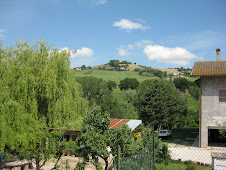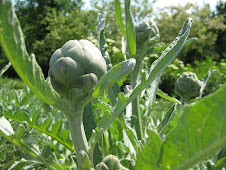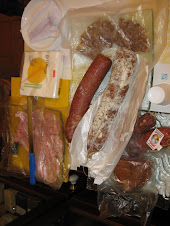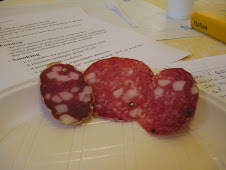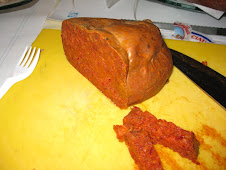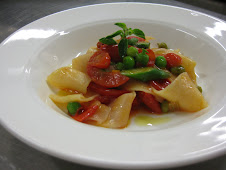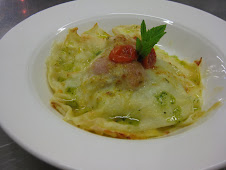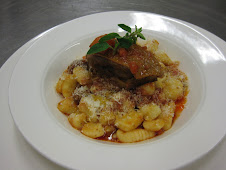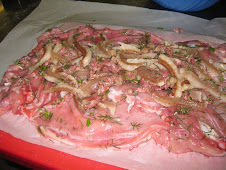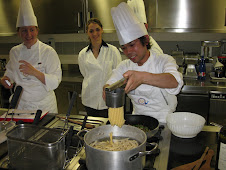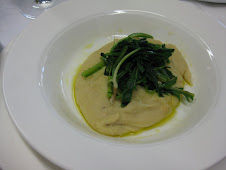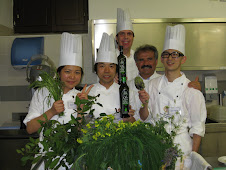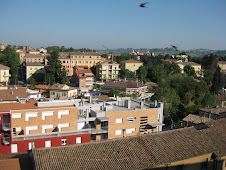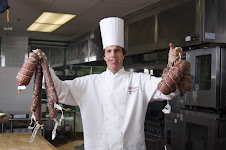La Cultura Gastronomica Della Costa Marchigiana
For two days we did nothing but cook some of the freshest, tastiest, and beautiful seafood of the March region with a wonderful Chef Massimo Bomprezzi. Massimo is a teacher at one of the finest schools in Italy, IPSSARCT “A . PAZINI” in Senigallia. Massimo did an excellent job organizing the class, and guiding us through production while we cooked all the delicate seafood to perfection, all in a tranquil environment.
Massimo made a couple of interesting points – We made many Brodetto’s – flavorful fish stews – but he explained that we would not use clams or mussels with the Brodettos because the fish swim freely, the clams are buried under sand, and the mussels are attached to something. They should not swim together in the broths.
He also said he does not like to use egg pastas with seafood. He prefers to use dry pasta for its flavor and texture with the fish and shell fish. We made:
Acciughe Marinate, Brodetto all Anconetana (Ancona Style), Brodetto alla Fanese (Fano Style), Brodo di Porto Recanati, Brodetto di San Benedetto, Vongole alla Poveraccia, Minestra di Pesce, Polipo con le Biete, Pesce alla Griglia, Raguse in Porchetta, Cozze Gratinate, Seppie con Fagioli, Stoccafisso all’ Anconetana, Tagliatelle con lo Stoccafisso, Zuppa Inglese, Granita all’ Arancia, Biscotti al Vino, Biscotti con le Mandorle, Cavallucci di Cingoli - Plus we made many dishes that were not on the menu like - Red Mullet Stuffed with Mussels and Wrapped with Guanciale, Baked Polombo - Shark, Mussels with Ray, Pannochie -Mantis Shrimp, Prawns, and Cozze in Brodo
When looking at the plan for all the weeks at the start of the course I was thinking that the class on seafood would be interesting, but not great. I was wrong. This turned out to be one of my favorite classes. Thanks Massimo!
Monday, June 30, 2008
Sunday, June 29, 2008
Visiting Umbria
Last week we had some visitors arrive and made a trip to Orvieto to visit a friend and as it turns out make a new one.
CJ Whitt a 2004 graduate from the International Culinary School at the Art Institute of Charlotte arrived on Wednesday and Ron Smith an instructor at the International Culinary School arrived on Sunday for about 2 weeks. Ron is spending part of the trip in Croatia. Me, Christine, Francesca, Greg, Gloria, & CJ went to Orvieto to visit our friend and collaborator Chef Lorenzo Polegri owner of Zeppelin Restaurant. Lorenzo takes our students for 3 month internships and was featured in the Italian DVD series shot for the international Culinary Schools. Lorenzo will also host our students for a study abroad course this fall. We also planned to visit Pasticceria Adriano the pastry shop of our pastry instructor for the upcoming class this week. We had a wonderful meal at Zeppelin restaurant and a very interesting and surprising tour of the Etruscan underground. As part of our visit to the pastry shop we were given a tour of 600 meters of underground cisterns, chambers, tunnels, and even ancient trash pits. You could see the black lines in the rock that are from the ash from when they burned the belongings of the plague victims. We were all taken by surprise by the immenseness of the Etruscan underground. This underground is owned by the pastry shop, and I will have much more detail on the owner Maurizio when I post on the pastry class.
We also had a wonderful dinner at a Slow Food restaurant overlooking Lake Bolsena. You arrive to this restaurant by driving a kilometer or so way up a hill on a dirt road. The place has its own garden, uses fish from the lake and local wine. The food is simple but uses stellar ingredients, and it is well prepared-you sit outside on the deck overlooking the lake, it is perfect.
While everyone was at the lake I took CJ to Civita, the “dying city” because it is such a unique place and I thought he would enjoy seeing it. You can only reach Civita by crossing a long foot bridge, there are only a few citizens left in the small town, but it offers stunning views, and some of the best bruschetta you will find. We went to the small little building that houses an ancient olive oil press, and serves bruschetta, and local wine. A young woman was there and I asked her were the man in picture on the wall was, because he made the bruschetta and poured the wine last time I visited. She explained that the man in the picture was her grandfather who had died over 10 years ago, that is was here father that I probably met, but she explained that they looked very much alike, and her was fine, just not there at the moment. I asked her how long the place was in her family and she said for 500 years! Wow-it made me think what will I be able to pass on to Francesca, I have a lot of thinking, and work to do. I asked the young women why she spoke English so well and she explained that she attended University in England. She said that after high school she felt she had to get away and experience the world, but now she could really appreciate her family place in Civita and felt it important to keep it alive. We talked for a while about culture, family, and tradition. She felt that England is in a similar boat to the US in regards to overall health and quality in the food system. She had been to NY and brought up a store that sold organic food, but it was so expensive only the wealthy could afford to shop there regularly, yes it was Whole Foods. She also brought up how MacDonald’s and Starbucks had taken over England. She said she understood how MacDonald’s infiltrated Italy, because of its appeal (brain washing) of children. But she stated that Starbucks will never succeed in Italy, that Italians will not drink a liter of coffee at time, or put all the syrups and junk in the coffee that turns coffee into some kind of sugary beverage with a splash of coffee. She is convinced that the coffee culture of Italy cannot be conquered by the US giant, I hope she is right. It was interesting to get a different perspective on these issues and a perfect setting for the discussion over delicious bruschetta-plain with olive oil and garlic, truffles & pecorino, and tomato & pecorino.
It was a great weekend of family, friends, food, and fun.
CJ Whitt a 2004 graduate from the International Culinary School at the Art Institute of Charlotte arrived on Wednesday and Ron Smith an instructor at the International Culinary School arrived on Sunday for about 2 weeks. Ron is spending part of the trip in Croatia. Me, Christine, Francesca, Greg, Gloria, & CJ went to Orvieto to visit our friend and collaborator Chef Lorenzo Polegri owner of Zeppelin Restaurant. Lorenzo takes our students for 3 month internships and was featured in the Italian DVD series shot for the international Culinary Schools. Lorenzo will also host our students for a study abroad course this fall. We also planned to visit Pasticceria Adriano the pastry shop of our pastry instructor for the upcoming class this week. We had a wonderful meal at Zeppelin restaurant and a very interesting and surprising tour of the Etruscan underground. As part of our visit to the pastry shop we were given a tour of 600 meters of underground cisterns, chambers, tunnels, and even ancient trash pits. You could see the black lines in the rock that are from the ash from when they burned the belongings of the plague victims. We were all taken by surprise by the immenseness of the Etruscan underground. This underground is owned by the pastry shop, and I will have much more detail on the owner Maurizio when I post on the pastry class.
We also had a wonderful dinner at a Slow Food restaurant overlooking Lake Bolsena. You arrive to this restaurant by driving a kilometer or so way up a hill on a dirt road. The place has its own garden, uses fish from the lake and local wine. The food is simple but uses stellar ingredients, and it is well prepared-you sit outside on the deck overlooking the lake, it is perfect.
While everyone was at the lake I took CJ to Civita, the “dying city” because it is such a unique place and I thought he would enjoy seeing it. You can only reach Civita by crossing a long foot bridge, there are only a few citizens left in the small town, but it offers stunning views, and some of the best bruschetta you will find. We went to the small little building that houses an ancient olive oil press, and serves bruschetta, and local wine. A young woman was there and I asked her were the man in picture on the wall was, because he made the bruschetta and poured the wine last time I visited. She explained that the man in the picture was her grandfather who had died over 10 years ago, that is was here father that I probably met, but she explained that they looked very much alike, and her was fine, just not there at the moment. I asked her how long the place was in her family and she said for 500 years! Wow-it made me think what will I be able to pass on to Francesca, I have a lot of thinking, and work to do. I asked the young women why she spoke English so well and she explained that she attended University in England. She said that after high school she felt she had to get away and experience the world, but now she could really appreciate her family place in Civita and felt it important to keep it alive. We talked for a while about culture, family, and tradition. She felt that England is in a similar boat to the US in regards to overall health and quality in the food system. She had been to NY and brought up a store that sold organic food, but it was so expensive only the wealthy could afford to shop there regularly, yes it was Whole Foods. She also brought up how MacDonald’s and Starbucks had taken over England. She said she understood how MacDonald’s infiltrated Italy, because of its appeal (brain washing) of children. But she stated that Starbucks will never succeed in Italy, that Italians will not drink a liter of coffee at time, or put all the syrups and junk in the coffee that turns coffee into some kind of sugary beverage with a splash of coffee. She is convinced that the coffee culture of Italy cannot be conquered by the US giant, I hope she is right. It was interesting to get a different perspective on these issues and a perfect setting for the discussion over delicious bruschetta-plain with olive oil and garlic, truffles & pecorino, and tomato & pecorino.
It was a great weekend of family, friends, food, and fun.
Thursday, June 26, 2008
The Veneto - Full of Suprises
When most Americans think of Italian food they probably are not thinking of Italian food from the Veneto region and in particular food from Venice and its immediate vicinity. When we think of spices used in Italian cuisine the first thing that comes to mind is not likely to be cinnamon, cardamom, turmeric, curry, licorice, star anise, coriander, or ginger, yet all these spices play a part in the unique, and wondrous cuisine of the Veneto region. It is said that of all the regions of Italy the cooking in the Veneto is the most varied. Not only is the territory diverse with mountains, hills, plains, lakes, rivers, the Adriatic sea, and the infamous lagoon of Venice, the region has been greatly influenced by many other foreign cultures. Because of its geographic location in Europe, as well as being on the Adriatic Coast, Venice which was founded in the year 400 became a mercantile powerhouse trading with many nations including Constantinople, Beirut, Egypt, China, Russia, India, Germany, France and England. Trade with these countries brought a great variety of ingredients, particularly spices to Venice which are still present in the cooking of the region today. Because of its trading prowess and wealth there was an old saying about Venice that “nothing is produced there but you can find everything”.
Venetian cooking has always had two distinct styles the festive highly spiced and elaborate dishes, and the more rustic, simple, traditional dishes based on locally grown products and courtyard animals. As in other parts of the world many dishes evolved because the technique and ingredients preserved the food. One of the most famous dishes of Venice is Sarde in Saor, and you can find other seafood, and vegetables like eggplant and pumpkin, in Saor. In Saor is a dish where the seafood or vegetables are cooked first then covered with a mixture of onions and vinegar that pickle and preserve the product so it can be stored and eaten at later time.
In the mountains the cooking is hearty and simple with dishes like polenta often served with game, mushrooms or alpine cheeses. Barely, beans, cabbage, beets, snails, potatoes, are common, and pumpkin if often used as filling for the casunziei (like ravioli).
The hills between Lake Garda and Venice is the prime wine producing area in t he Veneto with several DOC wine production zones. This area also produces the red Treviso radicchio and the variegated radicchio of Castelfranco. A famous dish of this area is Baccala alla Vicentina. An interesting fact is that in the Veneto Baccala is known as Stoccafisso or Stockfish.
The Po River valley is the primary agriculture area for the Veneto.
The area around Lake Garda has a mild climate and produces excellent olive oil, wine, and citrus fruits.
The lagoon and the coast of course provides plentiful seafood to be used in the wide array of dishes that the coast region is known for, shrimp, crustaceans, cuttlefish, little squid, Moeche crabs(small soft shell crabs), sardines, and prawns. We could list many more ingredients such as the famous Padua Hen, but will just have to finish by saying the Veneto is a rich region filled with diversity, and surprise!
Venetian cooking has always had two distinct styles the festive highly spiced and elaborate dishes, and the more rustic, simple, traditional dishes based on locally grown products and courtyard animals. As in other parts of the world many dishes evolved because the technique and ingredients preserved the food. One of the most famous dishes of Venice is Sarde in Saor, and you can find other seafood, and vegetables like eggplant and pumpkin, in Saor. In Saor is a dish where the seafood or vegetables are cooked first then covered with a mixture of onions and vinegar that pickle and preserve the product so it can be stored and eaten at later time.
In the mountains the cooking is hearty and simple with dishes like polenta often served with game, mushrooms or alpine cheeses. Barely, beans, cabbage, beets, snails, potatoes, are common, and pumpkin if often used as filling for the casunziei (like ravioli).
The hills between Lake Garda and Venice is the prime wine producing area in t he Veneto with several DOC wine production zones. This area also produces the red Treviso radicchio and the variegated radicchio of Castelfranco. A famous dish of this area is Baccala alla Vicentina. An interesting fact is that in the Veneto Baccala is known as Stoccafisso or Stockfish.
The Po River valley is the primary agriculture area for the Veneto.
The area around Lake Garda has a mild climate and produces excellent olive oil, wine, and citrus fruits.
The lagoon and the coast of course provides plentiful seafood to be used in the wide array of dishes that the coast region is known for, shrimp, crustaceans, cuttlefish, little squid, Moeche crabs(small soft shell crabs), sardines, and prawns. We could list many more ingredients such as the famous Padua Hen, but will just have to finish by saying the Veneto is a rich region filled with diversity, and surprise!
Sunday, June 22, 2008
Tasty Travels - Recent Field Trips
Parma – to a small organic Parmigiano Reggiano producer Azienda Agricola Biologica Ciaolatte who produces the milk, makes the cheese, and ages the cheese all on their property. They only produce about 5 wheels of parmesan a day. In their aging facility they had about 1000 wheels of parmesan in various stages of aging. Large facilities can easily have 10 times more cheese gaining. It was very informative to go through the steps of production, as well as discussing the consortium that inspects and approves all Parmigiano Reggiano Cheeses. We did a tasting of 12 month old, 24 month old, and 36 month old cheeses. It was very informative to taste these cheeses side by side and see how the color turned from off white to more yellow/tan. How the crystals were very small in the 12 month and grew more pronounced as the cheese aged, and how smooth and creamy the cheese was at 12 months, meaty and rich at 24 and full flavored and piccante at 36. We had wonderful lunch at Ciaolatte of classic dishes of the region and of course parmesan was featured in many of them a standout was a mousse made from Parmesan Reggiano and butter made from the cream that is skimmed from the milk during the cheese making process, it was decadent, delicious and dangerous. Call me Il Pancha!
Acetaia Dodi – Aceto Balsamico Tradizionale Di Reggio Emilia – We visited this producer of the magical elixir Aceto Balsamico Tradizionale, not the stuff you buy at the grocery store, the stuff that costs about 50 Euros for a 3.2 ounce bottle of 12 year old, or over 100 Euros for the 25 year old nectar. The vinegar is the cooked must from locally grown Trebbiano grapes. After being cooked down the must is transferred to barrels. The barrels are of various sizes and types of wood. This producer likes to use Chestnut, Cherry, European Oak, Ash, and Mulberry. 2/3 of the must is moved from barrel to barrel while 1/3 of the must always stay behind and is mixed with must from a different barrel. The must slowly evaporates through the wood, flavors concentrate, and become complex and the liquid becomes like syrup. The barrels are keep in the top floors of the house so in the summer they get very warm, and in the winter they get very cool. No heating, AC, or fans are allowed. The temperature changes and changes in humidity help the vinegar to develop it flavor and character. We did a tasting of the “at least” 12 to25 year old vinegars. All were delicious with complex flavors. The older vinegars being thicker, more concentrated and much more complex on the palate. These types of vinegar are not for salad dressings. We were told by the owner of Acetaia Dodi that the consortium only grades to the standards listed below and that vinegars listed as 75or 100 years old are marketing gimmicks, and are not consortium approved. That maybe some portion of the vinegar is that old, but likely not a majority.
· At least 12 years old Lobster Red Label – still has a good level of acidity-uses- carpaccio, crudities, shellfish, lamb chops, game, and poultry
· Silver Label – softer and sweeter – pasta, risotto, soufflés, sauces for fish, boiled met dishes, filet of beef, and duck liver
· Extra Vecchio –at least 25 years old –Gold Label – almost always used at the end of a meal-strong spicy cheeses, strawberries, and other berries, cherries, custards, and ice cream. The best is to sip from a spoon or a glass after a meal.
We must give our thanks to the great minds, products, and traditions that have developed and have keep alive two of the greatest food products we have today Parmigiano Reggiano and Aceto Balsamico Tradizionale.
We have visited a small Salumficio Artignale in the town of Matelica where we went through the process of making salami. The company produces several styles of salami is particularly noted for its Fabriano and Ciauscolo Salami. The products are very tasty.
We also visited a small organic farm that is part of the local agricultural university, Azienda Sperimenta di Agraria. Part of the program there is grow rare indigenous fruits and vegetables help to distribute them to farmers to help keep the species alive and to bring diversity to the market and the table. It was a beautiful farm and we enjoyed eating cherries from the trees.
We visited another small farm/agriturismo Salomone that mainly produced honey. We did a great tasting of many varieties of honey, saw how the honey is harvested and had a wonderful lunch.
Acetaia Dodi – Aceto Balsamico Tradizionale Di Reggio Emilia – We visited this producer of the magical elixir Aceto Balsamico Tradizionale, not the stuff you buy at the grocery store, the stuff that costs about 50 Euros for a 3.2 ounce bottle of 12 year old, or over 100 Euros for the 25 year old nectar. The vinegar is the cooked must from locally grown Trebbiano grapes. After being cooked down the must is transferred to barrels. The barrels are of various sizes and types of wood. This producer likes to use Chestnut, Cherry, European Oak, Ash, and Mulberry. 2/3 of the must is moved from barrel to barrel while 1/3 of the must always stay behind and is mixed with must from a different barrel. The must slowly evaporates through the wood, flavors concentrate, and become complex and the liquid becomes like syrup. The barrels are keep in the top floors of the house so in the summer they get very warm, and in the winter they get very cool. No heating, AC, or fans are allowed. The temperature changes and changes in humidity help the vinegar to develop it flavor and character. We did a tasting of the “at least” 12 to25 year old vinegars. All were delicious with complex flavors. The older vinegars being thicker, more concentrated and much more complex on the palate. These types of vinegar are not for salad dressings. We were told by the owner of Acetaia Dodi that the consortium only grades to the standards listed below and that vinegars listed as 75or 100 years old are marketing gimmicks, and are not consortium approved. That maybe some portion of the vinegar is that old, but likely not a majority.
· At least 12 years old Lobster Red Label – still has a good level of acidity-uses- carpaccio, crudities, shellfish, lamb chops, game, and poultry
· Silver Label – softer and sweeter – pasta, risotto, soufflés, sauces for fish, boiled met dishes, filet of beef, and duck liver
· Extra Vecchio –at least 25 years old –Gold Label – almost always used at the end of a meal-strong spicy cheeses, strawberries, and other berries, cherries, custards, and ice cream. The best is to sip from a spoon or a glass after a meal.
We must give our thanks to the great minds, products, and traditions that have developed and have keep alive two of the greatest food products we have today Parmigiano Reggiano and Aceto Balsamico Tradizionale.
We have visited a small Salumficio Artignale in the town of Matelica where we went through the process of making salami. The company produces several styles of salami is particularly noted for its Fabriano and Ciauscolo Salami. The products are very tasty.
We also visited a small organic farm that is part of the local agricultural university, Azienda Sperimenta di Agraria. Part of the program there is grow rare indigenous fruits and vegetables help to distribute them to farmers to help keep the species alive and to bring diversity to the market and the table. It was a beautiful farm and we enjoyed eating cherries from the trees.
We visited another small farm/agriturismo Salomone that mainly produced honey. We did a great tasting of many varieties of honey, saw how the honey is harvested and had a wonderful lunch.
Thursday, June 19, 2008
The Inevitable Evil
One part of this program among many that has been pretty cool and very informative has been the monothematic classes on Olive Oil with Renzo Ceccaci. We have tasted about 12 oils a session and have focused on finding flaws and positive qualities in the oil. We got into the science of olive oil, the growth, production, and storage. It is interesting to note that olive oil and breast milk have the same ratio of essential fatty acids, and that consumption of 30 grams of Olive Oil a day can help reduce the risks of many types of cancer. Our final for the class was to blindly smell and identify 4 of the majors flaws found in Olive Oils. During our tasting of 36 or more Olive oils during the class it is interesting to note that we found serious flaws in several of them. These were not “plants” by the teacher, but actually poor quality Extra Virgin Olive Oil bought at the store, and one that was entered into a contest at a food tradeshow. Buyer Beware!!! The four major flaws found in Olive Oil are:
1. Riscaldo – Heated – at some point during either transport – production the olives have been heated. The smell is of strong olives, but also a kind of rancid smell.
2. Avvinato –winey or vinegar aroma and taste – caused by bacteria
3. Muffa – mold – smells moldy and of paint-olives stored in wet or damp areas
4. Morchia – Marc-to long of contact with its marc or sediment. Smells really bad like smelly feet.
5. Rancido –Rancid – exposed to light, air, heat -smells of cardboard-rancid smell
The “inevitable evil” is the entire period of processing when the olives and its oil can become tainted.
Only use Extra Virgin Olive Oil, not Olive Oil, or Pomace Olive Oil. Products marketed as “Olive Oil” are almost tasteless and odorless and have a much lower content of all the substances (like polyphenols) that make extra virgin olive oil so tasty and nutritious. In olive oil production oil that has above 2% acidity and some of the above flaws will be classified as lamp oil and is unfit for human consumption. This oil can be sent to a refinery, deodorized, de-colored, de-acidified by chemical and physical processes and transformed into Refined Olive Oil. Then it can have an unspecified amount of Extra Virgin Olive Oil added and be retailed as Olive Oil. Only buy Extra Virgin Olive Oil!!!
1. Riscaldo – Heated – at some point during either transport – production the olives have been heated. The smell is of strong olives, but also a kind of rancid smell.
2. Avvinato –winey or vinegar aroma and taste – caused by bacteria
3. Muffa – mold – smells moldy and of paint-olives stored in wet or damp areas
4. Morchia – Marc-to long of contact with its marc or sediment. Smells really bad like smelly feet.
5. Rancido –Rancid – exposed to light, air, heat -smells of cardboard-rancid smell
The “inevitable evil” is the entire period of processing when the olives and its oil can become tainted.
Only use Extra Virgin Olive Oil, not Olive Oil, or Pomace Olive Oil. Products marketed as “Olive Oil” are almost tasteless and odorless and have a much lower content of all the substances (like polyphenols) that make extra virgin olive oil so tasty and nutritious. In olive oil production oil that has above 2% acidity and some of the above flaws will be classified as lamp oil and is unfit for human consumption. This oil can be sent to a refinery, deodorized, de-colored, de-acidified by chemical and physical processes and transformed into Refined Olive Oil. Then it can have an unspecified amount of Extra Virgin Olive Oil added and be retailed as Olive Oil. Only buy Extra Virgin Olive Oil!!!
Saturday, June 14, 2008
We are Tuscans!
For the region of Tuscany we had a fun energetic Chef named Marco Stabile who owns one of the top rated restaurants in Florence, Ora di Aria. We did one day of traditional Tuscan cooking and one day of modern interpretations of classic Tuscan combinations, and as you can see from the pictures we did some cool stuff. Marco really stressed knowing tradition and classical dishes before you started trying to changes dishes, create fusion dishes, or experiment without foundation. He stated “everything starts with tradition, and then you can evolve from that historical point”. He also said it was “molto importante to study the history of the town you work in” so you know what your customers likes, dislikes, and culture expectations are. “Tendencies are tied to the past …everything is tied together, know the history, but add your own style-understand the past –it helps you look to the future”. Marco had spent time working in a Michelin two star restaurant and is well versed in both classical and modern cuisines.
Although the Chianina is known for its Bistecca, Marco said he prefers its meat braised or Bolito because the animal is a very strong breed and develops muscle so the long slow cooking works well with its meat. He stated that Tuscans don’t like their desserts too sweet, and two of the most popular Cantuccini and Brutti ma Buoni are not overly sweet, but they do like to consume them particularly the Cantuccini with Vin Santo, a sweet dessert wine. Panforte di Siena is very sweet, but he said in Italy is usually just eaten around Christmas. Marco explained that the north of Tuscany is influenced by Bologna and uses fresh egg pasta, south of Florence the region does not use much fresh pasta and uses more vegetables, stews and grilled meats. The famous soup of the region Ribollita has many variations and the ingredients change with the season. Marco did a cool thing and took parmesan rind that had maybe a 1/8 inch of cheese on it and baked them until they were puffed up and crunchy, and really tasty. He said it is cool to dice them and use them for croutons.
Tuscany gets all the press, and it is easy to get jaded and think it is overblown. But, there is something about the region that is regal and distinct. Driving through Tuscany you feel as if the countryside has been manicured and prepared for your visit. Perhaps it is the contrast of the beautiful golden rolling hills, the tall coned shaped green Cypress trees that jut high above the fields, the hilltop towns, and the old stone farmhouses. Whatever it is the region has an undeniable presence.
The Etruscans cultivated the land in what is now Tuscany 2500 years ago. Today the region is full of tradition and produces many products that are known throughout the world. Although the region is rich in gastronomic products it is known for dishes which are humble, simple in composition, and often making use of “leftovers”. One notable exception to this rule is the famous behemoth Bistecca alla Fiorentina, the great grilled steak from the Chianina cow. Tuscany is known for excellent cured meats like salumi, prosciutto, and lardo de Colonnata from Carrara, a delectable cured fat that melts from your body temperature as you eat. There has also been a revival of a breed of pig called the Cinta Senese which is considered to have superior quality meat for curing, in our region we may compare the qualities of the Ossabaw with the Cinta Senese. The cheese produced in Tuscany tends to be sheep’s milk cheese and can range from fresh and delicate to aged and piccante.
Most people know about Tuscan bread and how they do not use salt in their bread. One reason for this is because it goes well with the salty salami which is produced in the region. The other reason behind making the bread without salt is for preservation purposes. If there is salt in the bread, the salt attracts moisture and eventually the bread gets soft from absorbing moisture. Without the salt the bread will last for several days, and eventually dry. Traditionally bread was made once a week, on Sundays. A little bit of fresh bread would be eaten on Sunday, and then for the next couple of days. By the end of the week the bread was getting dry and hard, therefore dishes were developed to utilize the bread with various other seasonal ingredients thus we find recipes like Panzanella, Ribolita or Minestra di Pane, and Pappa al Pomodoro.
The entire world knows that Tuscany is synonymous with Chianti, but the region also produces many other fine wines like Brunello and Rosso di Montalcino, Vino Nobile di Montipulciano, Carmignano, Morellino di Scansano, Vernacchia di San Gimignano, and the Bologheri area of Tuscany is known as the Italian Bordeaux because of its production of big red wines.
There is not enough space here to discuss all that Tuscany has to offer, but other common products include excellent olive oil, Farro (Spelt Wheat), a wide array of fresh and dried beans, chicken, pigeon, and rabbit, and even fish such as prawns, squid, octopus, and cuttlefish as Tuscany has miles of coastline. We made: Carabaccia, Panzanella, Tortell di Patate, Cavolo Nero Con le Fete, Crostini di Fegatini al Vin Santo, Farinata con Cavolo Nero, Minestra di Pane, Pappa al Pomodoro, Ravioli Gnudi alla Fiorentina, Trippa alla Fiorentina, Fagioli all’ Uccelletto, Cantuccini di Prato, Brutti ma Buoni, Ricciarelli di Siena, Panforte di Siena, Carciofo Alla Toscana Animelle di Vitello Croccanti, Tortelli di Vongole e Zucchine con Fonduta, Farro con Petto di Piccione Arancia e Olive Amare, Uovo di Paolo Parisi, Tartara di Tonno con Falso Uovo di Baccala, Pomodoro Confit Ripieno di Burrata, emulsion tiepida di basilico e pepe di Sezchouan, Grissini all’ Origano Fresco
Although the Chianina is known for its Bistecca, Marco said he prefers its meat braised or Bolito because the animal is a very strong breed and develops muscle so the long slow cooking works well with its meat. He stated that Tuscans don’t like their desserts too sweet, and two of the most popular Cantuccini and Brutti ma Buoni are not overly sweet, but they do like to consume them particularly the Cantuccini with Vin Santo, a sweet dessert wine. Panforte di Siena is very sweet, but he said in Italy is usually just eaten around Christmas. Marco explained that the north of Tuscany is influenced by Bologna and uses fresh egg pasta, south of Florence the region does not use much fresh pasta and uses more vegetables, stews and grilled meats. The famous soup of the region Ribollita has many variations and the ingredients change with the season. Marco did a cool thing and took parmesan rind that had maybe a 1/8 inch of cheese on it and baked them until they were puffed up and crunchy, and really tasty. He said it is cool to dice them and use them for croutons.
Tuscany gets all the press, and it is easy to get jaded and think it is overblown. But, there is something about the region that is regal and distinct. Driving through Tuscany you feel as if the countryside has been manicured and prepared for your visit. Perhaps it is the contrast of the beautiful golden rolling hills, the tall coned shaped green Cypress trees that jut high above the fields, the hilltop towns, and the old stone farmhouses. Whatever it is the region has an undeniable presence.
The Etruscans cultivated the land in what is now Tuscany 2500 years ago. Today the region is full of tradition and produces many products that are known throughout the world. Although the region is rich in gastronomic products it is known for dishes which are humble, simple in composition, and often making use of “leftovers”. One notable exception to this rule is the famous behemoth Bistecca alla Fiorentina, the great grilled steak from the Chianina cow. Tuscany is known for excellent cured meats like salumi, prosciutto, and lardo de Colonnata from Carrara, a delectable cured fat that melts from your body temperature as you eat. There has also been a revival of a breed of pig called the Cinta Senese which is considered to have superior quality meat for curing, in our region we may compare the qualities of the Ossabaw with the Cinta Senese. The cheese produced in Tuscany tends to be sheep’s milk cheese and can range from fresh and delicate to aged and piccante.
Most people know about Tuscan bread and how they do not use salt in their bread. One reason for this is because it goes well with the salty salami which is produced in the region. The other reason behind making the bread without salt is for preservation purposes. If there is salt in the bread, the salt attracts moisture and eventually the bread gets soft from absorbing moisture. Without the salt the bread will last for several days, and eventually dry. Traditionally bread was made once a week, on Sundays. A little bit of fresh bread would be eaten on Sunday, and then for the next couple of days. By the end of the week the bread was getting dry and hard, therefore dishes were developed to utilize the bread with various other seasonal ingredients thus we find recipes like Panzanella, Ribolita or Minestra di Pane, and Pappa al Pomodoro.
The entire world knows that Tuscany is synonymous with Chianti, but the region also produces many other fine wines like Brunello and Rosso di Montalcino, Vino Nobile di Montipulciano, Carmignano, Morellino di Scansano, Vernacchia di San Gimignano, and the Bologheri area of Tuscany is known as the Italian Bordeaux because of its production of big red wines.
There is not enough space here to discuss all that Tuscany has to offer, but other common products include excellent olive oil, Farro (Spelt Wheat), a wide array of fresh and dried beans, chicken, pigeon, and rabbit, and even fish such as prawns, squid, octopus, and cuttlefish as Tuscany has miles of coastline. We made: Carabaccia, Panzanella, Tortell di Patate, Cavolo Nero Con le Fete, Crostini di Fegatini al Vin Santo, Farinata con Cavolo Nero, Minestra di Pane, Pappa al Pomodoro, Ravioli Gnudi alla Fiorentina, Trippa alla Fiorentina, Fagioli all’ Uccelletto, Cantuccini di Prato, Brutti ma Buoni, Ricciarelli di Siena, Panforte di Siena, Carciofo Alla Toscana Animelle di Vitello Croccanti, Tortelli di Vongole e Zucchine con Fonduta, Farro con Petto di Piccione Arancia e Olive Amare, Uovo di Paolo Parisi, Tartara di Tonno con Falso Uovo di Baccala, Pomodoro Confit Ripieno di Burrata, emulsion tiepida di basilico e pepe di Sezchouan, Grissini all’ Origano Fresco
Thursday, June 12, 2008
Isola Giglio
This weekend we took another trip to Tuscany, but this time we went to visit Chef Marcella Ansaldo on the island of Giglio, her home town. I met Marcella last year in Charlotte when she conducted some classes for our local Slow Food Convivium. Marcella currently teaches Italian cooking at the school Apicius in Florence. Marcella contacted me the day I arrived in Italy and we had planned to get together earlier, but unfortunately her son had a bad motorcycle accident and has been slowly recovering, first in the hospital and now at home. He is still unable to walk, but Marcella thinks he will be able to in a 1 o 2 weeks.
The last ferry to Giglio leaves Porto Saint Stefano at about 7:30PM – the drive from Jesi is about 3.5 to 4 hours, so the ferry is too early for us to make after class on Friday evening. With Marcella’s ok, I invited the other students in the class to come and Toshi, Sadao, and Masa came with Christine, Francesca, and I, but Jennifer stayed to meet some friends in Ancona. We decided to drive ¾ of the way Friday evening and spend the night in Siena. Siena is a beautiful city; I think the Piazza Del Campo is probably the most striking Piazza that I have seen. Last year when we were in Siena it was set up for the Palio – so there was dirt and grand stands filling most of the Piazza. This time I stood alone in the Piazza at 7:00 am – it was awesome. Marcella drove to Siena to meet us for dinner and she hit it off with my classmates, Christine and Francesca immediately.
Saturday morning we headed for the small island of Gilgio which has a population of about 1000. It is wonderful to hear Marcella speak with such passion about her island. As soon as we walked off the ferry she was hugging and kissing people, it seemed as if she knew everyone on the island. Is was interesting hearing about how the Romans used the island for wine production and to see the old roman foundations. The island has three main parts all very different Porto, Castello on the hill top, and the beaches. Marcella has dreams of building a school, and cultural center on the island. She is currently working the local government trying to make her dream become a reality. I hope she does as the island and its people have much more to offer than crystal clear water and beautiful beaches.
Other thoughts: - Not to sound like a broken record, or preachy or that I don’t love the US, but I had some thoughts and observations over the weekend.
Francesca fell asleep during dinner in Siena on Friday night so I needed to carry her back to the hotel when we were done. We took a lovely walk through the city and came to a set a stairs to go down. Usually I would just quickly walk down the stairs without a thought, but since I was carrying a sleeping Francesca and could not see down in front of me I walked carefully sliding my feet down the stairs so I wouldn’t trip. I noticed the steps were very smooth, slightly slanted and rounded on the edges. As I went down I thought how many hundred years old these steps must be, how many thousands of people have gone down them to smooth and round them, and how many hundred years more will they be there after I have gone? For some reason my first thought was how fleeting our time is here on earth and that I should enjoy each moment and step. Stay in the moment and don’t worry about yesterday or tomorrow. Then I thought why we (America) look at things so differently than other cultures. It seems we may have viewed the steps as “old”, “worn out”, needs to be “replaced”. Yet the steps still work, they tie us to the past and help make one small connection with those who came before and those who may come after us. I thought of where I live and how we viewed a perfectly good less than 20 year old, multimillion dollar structure (the Charlotte Coliseum) and blew it up so we could move it 5 miles to downtown? How strange? How disposable our culture has become, it does not make much sense to me.
Driving from Siena to Porto Santo Stefano we stopped at a gas station (not an Auto Grill – but a small unassuming place) to get a café. Like all the roadside bars in Italy you can get a great café. But, when you ordered an orange juice, the guy took a couple of oranges cut them in half, juiced them, and gave you a glass of orange juice. In the US you can get a good coffee and a fresh squeezed OJ in the big city, but what do you get on the side of the highway or small towns for the most part? The simple answer-junk food – you know the names. Why do we put up with it? It is crazy we can get an egg mcmuffin and crappy coffee, and orange juice from concentrate or powder. We can get a Walmart, a gas station with a junk food vendor inside, but can we can something simple, fresh, healthy and good? The little beach huts on Giglio actually had fresh, made to order food. Not microwave hotdogs and burritos. One had a wood burning pizza oven waiting to make you a fresh pizza, they had salads, pastas, and great café. The other had the chef waiting to make you fresh mussels, or pasta. The beach was tiny –like 20 yards- there were 6 tables. These were on the beach, not in town. Why don’t we demand quality, are our bodies and minds not worth it?
Stand up and scream “I mad as hell and I am not gonna take it anymore” come on you can do it – did you see the movie?
The last ferry to Giglio leaves Porto Saint Stefano at about 7:30PM – the drive from Jesi is about 3.5 to 4 hours, so the ferry is too early for us to make after class on Friday evening. With Marcella’s ok, I invited the other students in the class to come and Toshi, Sadao, and Masa came with Christine, Francesca, and I, but Jennifer stayed to meet some friends in Ancona. We decided to drive ¾ of the way Friday evening and spend the night in Siena. Siena is a beautiful city; I think the Piazza Del Campo is probably the most striking Piazza that I have seen. Last year when we were in Siena it was set up for the Palio – so there was dirt and grand stands filling most of the Piazza. This time I stood alone in the Piazza at 7:00 am – it was awesome. Marcella drove to Siena to meet us for dinner and she hit it off with my classmates, Christine and Francesca immediately.
Saturday morning we headed for the small island of Gilgio which has a population of about 1000. It is wonderful to hear Marcella speak with such passion about her island. As soon as we walked off the ferry she was hugging and kissing people, it seemed as if she knew everyone on the island. Is was interesting hearing about how the Romans used the island for wine production and to see the old roman foundations. The island has three main parts all very different Porto, Castello on the hill top, and the beaches. Marcella has dreams of building a school, and cultural center on the island. She is currently working the local government trying to make her dream become a reality. I hope she does as the island and its people have much more to offer than crystal clear water and beautiful beaches.
Other thoughts: - Not to sound like a broken record, or preachy or that I don’t love the US, but I had some thoughts and observations over the weekend.
Francesca fell asleep during dinner in Siena on Friday night so I needed to carry her back to the hotel when we were done. We took a lovely walk through the city and came to a set a stairs to go down. Usually I would just quickly walk down the stairs without a thought, but since I was carrying a sleeping Francesca and could not see down in front of me I walked carefully sliding my feet down the stairs so I wouldn’t trip. I noticed the steps were very smooth, slightly slanted and rounded on the edges. As I went down I thought how many hundred years old these steps must be, how many thousands of people have gone down them to smooth and round them, and how many hundred years more will they be there after I have gone? For some reason my first thought was how fleeting our time is here on earth and that I should enjoy each moment and step. Stay in the moment and don’t worry about yesterday or tomorrow. Then I thought why we (America) look at things so differently than other cultures. It seems we may have viewed the steps as “old”, “worn out”, needs to be “replaced”. Yet the steps still work, they tie us to the past and help make one small connection with those who came before and those who may come after us. I thought of where I live and how we viewed a perfectly good less than 20 year old, multimillion dollar structure (the Charlotte Coliseum) and blew it up so we could move it 5 miles to downtown? How strange? How disposable our culture has become, it does not make much sense to me.
Driving from Siena to Porto Santo Stefano we stopped at a gas station (not an Auto Grill – but a small unassuming place) to get a café. Like all the roadside bars in Italy you can get a great café. But, when you ordered an orange juice, the guy took a couple of oranges cut them in half, juiced them, and gave you a glass of orange juice. In the US you can get a good coffee and a fresh squeezed OJ in the big city, but what do you get on the side of the highway or small towns for the most part? The simple answer-junk food – you know the names. Why do we put up with it? It is crazy we can get an egg mcmuffin and crappy coffee, and orange juice from concentrate or powder. We can get a Walmart, a gas station with a junk food vendor inside, but can we can something simple, fresh, healthy and good? The little beach huts on Giglio actually had fresh, made to order food. Not microwave hotdogs and burritos. One had a wood burning pizza oven waiting to make you a fresh pizza, they had salads, pastas, and great café. The other had the chef waiting to make you fresh mussels, or pasta. The beach was tiny –like 20 yards- there were 6 tables. These were on the beach, not in town. Why don’t we demand quality, are our bodies and minds not worth it?
Stand up and scream “I mad as hell and I am not gonna take it anymore” come on you can do it – did you see the movie?
Wednesday, June 4, 2008
Emilia-Romagna - Pasta!!
The region of Emilia-Romagna contains some of the greatest treasures of Italian cuisine with well know cities like Parma, Modena, and Bologna lending their names to products like Prosciutto Di Parma, Parmesan Reggiano, Aceto Balsamico Tradizionale di Modena, and Ragu Bolognese to name a few. To many people the city of Bologna is considered the gastronomic capital of Italy. The city is known as Bologna La Grassa or Bologna the Fat. I think that after my course I may be known as Joe the Fat, I feel my borders expanding. The city is famous for it’ s Mortadella , the often huge yet delicate and wonderful cured meat invented by the Romans about 2000 years ago, and resembling nothing like it’s bastard child in the US bologna. The city is also well known for several pasta dishes Tagliatelle Bolognese, Lasagna, and Tortellini in Brodo, but Bologna is not the only city in Emilia-Romagna known for its pasta, fresh pasta is the common denominator for the region. Parma and Agnolotti, Reggio Emilia – Cappelletti, Modena –Tortellini (along with Bologna), Ferrara-Tortelli di Zucca (pumpkin), and Piacenza-Pisarei .
The pasta of Emilia Romagna is rich egg pasta that is typically quite yellow from the abundance of egg yolks used in the dough. Regardless of the individual variations in the region the sfoglia produced is rich, fine and subtle perfect for making any of the famous pasta dishes of the region like lasagna, tortellini, cappaletti, cappalucci, cannelloni, tortelli, anglotti,and garganelli. It is quite amazing to see someone roll out a ball of pasta to the size of a bed sheet, and use the matterello (long rolling pin) to hold it up high like a curtain so you can see through it, all in a matter of 2 minutes.
The region currently has over 20 products that are either DOP (registered designation of origin), or IGP (registered geographic designation of origin) the highest in Italy. There are several reasons that this region is so capable of producing such high quality products born from its land. The geography of the region creates several micro-climates which creates the conditions that are required for man and nature to work their magic. The Po River runs through the region depositing rich sediment in the valley, providing water to the region, and producing humidity which is essential for curing the great meats of the region. The Po River bed, The Apennine Mountains, and the sea are the magical combination. The region not only produces great cheeses, meats, and pastas, fruits and vegetables such as grapes, peaches, plums, cherries, apricots, tomatoes, and wheat.
Obviously meat is important and pork, veal, beef, horse, rabbit, and lamb are common. One doesn’t usually think of seafood and the Emilia-Romagna, but on the Romagna side(eastern part) the region reaches to the Adriatic and fish is more often found.
Lambrusco is produced in great quantities. Lambrusco is not held in high esteem as many Italian wins, but there is a history and reason for consuming this wine in the region. The effervescence and fruitiness of the wine helps to cut the fattiness and rich of the cuisine of this region, it is a perfect match!
Just imagine trying to cook without Parmesan Reggiano, thank goodness for the Emilia-Romagna.
We had a great time making a variety of fresh pastas. We all had sore shoulders from kneading dough – it was awesome!!We made Punta di Vitello al Forno, Lasagne alla Bolognese, Agnolotti, Cappelletti all Reggiana, Tortellini Modenesi, Tortelli di Zucca, Stricchetti with Herbs and Tomatoes, Tortelli D’ Erbetta, Pisarei e Faso, Gnocco Fritto, Piadina Romangnola, Farfalle, Cured Meat Platters
The pasta of Emilia Romagna is rich egg pasta that is typically quite yellow from the abundance of egg yolks used in the dough. Regardless of the individual variations in the region the sfoglia produced is rich, fine and subtle perfect for making any of the famous pasta dishes of the region like lasagna, tortellini, cappaletti, cappalucci, cannelloni, tortelli, anglotti,and garganelli. It is quite amazing to see someone roll out a ball of pasta to the size of a bed sheet, and use the matterello (long rolling pin) to hold it up high like a curtain so you can see through it, all in a matter of 2 minutes.
The region currently has over 20 products that are either DOP (registered designation of origin), or IGP (registered geographic designation of origin) the highest in Italy. There are several reasons that this region is so capable of producing such high quality products born from its land. The geography of the region creates several micro-climates which creates the conditions that are required for man and nature to work their magic. The Po River runs through the region depositing rich sediment in the valley, providing water to the region, and producing humidity which is essential for curing the great meats of the region. The Po River bed, The Apennine Mountains, and the sea are the magical combination. The region not only produces great cheeses, meats, and pastas, fruits and vegetables such as grapes, peaches, plums, cherries, apricots, tomatoes, and wheat.
Obviously meat is important and pork, veal, beef, horse, rabbit, and lamb are common. One doesn’t usually think of seafood and the Emilia-Romagna, but on the Romagna side(eastern part) the region reaches to the Adriatic and fish is more often found.
Lambrusco is produced in great quantities. Lambrusco is not held in high esteem as many Italian wins, but there is a history and reason for consuming this wine in the region. The effervescence and fruitiness of the wine helps to cut the fattiness and rich of the cuisine of this region, it is a perfect match!
Just imagine trying to cook without Parmesan Reggiano, thank goodness for the Emilia-Romagna.
We had a great time making a variety of fresh pastas. We all had sore shoulders from kneading dough – it was awesome!!We made Punta di Vitello al Forno, Lasagne alla Bolognese, Agnolotti, Cappelletti all Reggiana, Tortellini Modenesi, Tortelli di Zucca, Stricchetti with Herbs and Tomatoes, Tortelli D’ Erbetta, Pisarei e Faso, Gnocco Fritto, Piadina Romangnola, Farfalle, Cured Meat Platters
Labels:
cooking,
emilia romagna,
Italcook,
italian,
slow food
Festa della Repubblica
This past weekend was a holiday weekend in Italy, the Festa della Repubblica. We decided to take advantage of the Monday holiday and visited Florence for the weekend. Florence is such a beautiful and historic city that is full of wonder, and tourists. The city is not only an international tourist destination, but also for Italians, especially on a holiday weekend. Francesca made a little friend and we all had a wonderful time.We visited the restaurant Ora D' Aria which is owned by our Chef/Instructor from Tuscany Marco Stabile. The restaurant is a small 50 seat restaurant and is rated among the best in Florence. It is a beautiful place and Marco does modern takes on classic Tuscan Cuisine. You will see more when I do my Tuscany Post
Subscribe to:
Posts (Atom)
